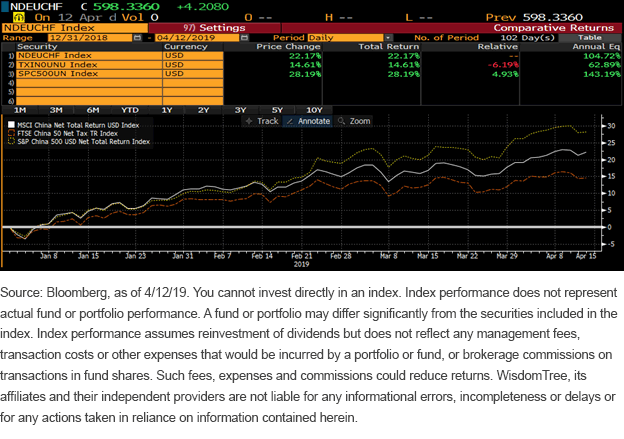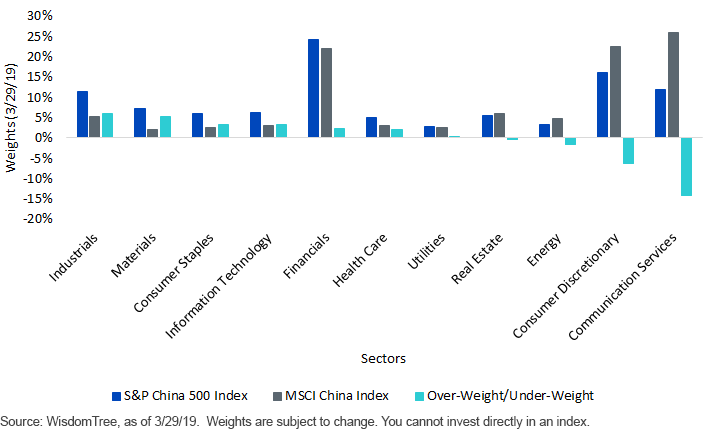U.S.-China Trade: When vs. What


If we break down investing into two principal components, most questions typically center upon when to buy or sell and what to buy or sell.
The trade war between the U.S. and China over the last 16 months has encouraged investors without a dedicated position in China to focus almost exclusively on the first question of when to buy.
In our view, a formal trade agreement is likely to be signed before the G20 meeting in June. In response, investors may want to have a plan in place, as China is simply too large an opportunity to ignore in global portfolios.
As confidence in an impending deal has grown, global equity markets have rebounded sharply following a painful fourth quarter in 2018. But there’s a wide degree of dispersion between different measures of Chinese markets, where the question of what to buy or sell takes priority.
In figure 1 below, we show three commonly followed Chinese equity benchmarks. Unfortunately, if investors gained exposure via the FTSE China 50 Index, their returns would only be about half as much as 2019’s top performer, the S&P China 500 Index. The considerable underperformance of the MSCI China Index to start the year also leaves much to be desired.
While investors should be comfortable with greater volatility in China than in developed markets, we’ve outlined three basic factors that can help investors avoid some of the pitfalls of Chinese stocks.
Figure 1: YTD Performance of Major Chinese Indexes

1. Number of Holdings
In the U.S., most commonly followed large-cap benchmarks from S&P and Russell have anywhere from 500 to 1,000 stocks. Chinese benchmarks tend to be more concentrated. For example, the FTSE China 50 Index only holds 50 names. For an economy as large and dynamic as China’s, it seems like gaining exposure through 50 stocks is counterintuitive, and may help explain why the index has lagged to begin the year. While the MSCI China Index currently holds 469 stocks, our current favorite benchmark for beta is the S&P China 500 Index, which follows a comparable index methodology to the S&P 500 Index in the U.S.
2. Sector Concentration
Most investors targeting beta exposure to China are unlikely to have a strong view on individual sectors. Like the S&P 500 in the U.S., the S&P China 500 Index offers comprehensive exposure to all areas of the Chinese economy without making oversized bets on particular sectors. The MSCI China Index, however, consolidates more than 70% of its overall weight in the Communication Services, Financials and Consumer Discretionary sectors. By comparison, the S&P China 500 Index sports an aggregate 18% underweight to these three sectors. That’s a more modest 52% of the total index. In our view, the S&P China 500 Index has the unique potential to mitigate the concentration risk that lurks in other approaches.
Figure 2: S&P China 500 Index vs. MSCI China Index–Sector Weights

3. Share Classes
In January, MSCI announced that it would accelerate the pace of inclusion of Chinese A-shares in its indexes. While this announcement may have flown under the radar, due to macro headwinds from trade, it marks yet another step in the process of financial market liberalization in China.
In our view, A-shares represent an opportunity to broaden exposure to companies listing on mainland exchanges, and possibly tap new sources of alpha. The S&P China 500 Index currently maintains a 50% overweight to A-shares compared to the MSCI China Index. Even after their inclusion process is complete, the S&P China 500 Index will still hold nearly 40% more in A-Shares (52% vs. 10%). The FTSE China 50 Index currently does not include exposure to China A. Going forward, we anticipate a gradual shift as more Chinese companies migrate from Hong Kong to mainland exchanges. Investing in China may increasingly mean investing onshore as the Chinese market increases foreign access to their markets.
Final Thoughts
As the two largest economies in the world, the U.S. and China, and their relations with each other, dictate the tone for global markets. While the U.S. has been a leader in global capital markets for nearly a decade, China’s rise is still in its infancy.
We continue to believe that a convergence is well underway between the role China plays in the global economy and the role that it will eventually play in global portfolios. In our view, the WisdomTree ICBCSS S&P China 500 Fund (WCHN) represents one of the best ways for investors to gain access to beta in Chinese markets.
Important Risks Related to this Article
There are risks associated with investing, including possible loss of principal. Foreign investing involves special risks, such as risk of loss from currency fluctuation or political or economic uncertainty. The Fund focuses its investments in China, including A-shares, which include risk of the RQFII regime and Stock Connect program, thereby increasing the impact of events and developments associated with the region which can adversely affect performance. Investments in emerging or offshore markets are generally less liquid and less efficient than investments in developed markets and are subject to additional risks, such as risks of adverse governmental regulation and intervention or political developments. The Fund’s exposure to certain sectors may increase its vulnerability to any single economic or regulatory development related to such sectors. As this Fund can have a high concentration in some issuers, the Fund can be adversely impacted by changes affecting those issuers. The Fund will be required to include cash as part of its redemption proceeds which introduces additional risks, particularly due to the potential volatility in the Chinese market and market closures. The Fund invests in the securities included in, or representative of, its Index regardless of their investment merit and the Fund does not attempt to outperform its Index or take defensive positions in declining markets. Due to the investment strategy of this Fund it may make higher capital gain distributions than other ETFs. Please read the Fund’s prospectus for specific details regarding the Fund’s risk profile.

Brian Manby joined WisdomTree in October 2018 as an Investment Strategy Analyst. He is responsible for assisting in the creation and analysis of WisdomTree’s model portfolios, as well as helping support the firm’s research efforts. Prior to joining WisdomTree, he worked for FactSet Research Systems, Inc. as a Senior Consultant, where he assisted clients in the creation, maintenance and support of FactSet products in the investment management workflow. Brian received a B.A. as a dual major in Economics and Political Science from the University of Connecticut in 2016. He is holder of the Chartered Financial Analyst designation.

